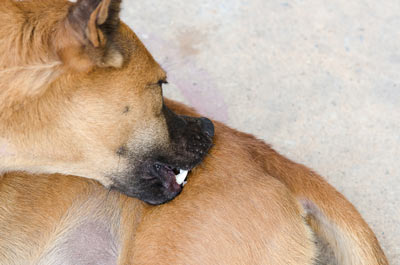Does Your Dog Have Hairy Teeth?

Have you ever lifted up your dog's lip to reveal the bazaar sight of hair apparently growing out from under his gums?
"Help! My dog has hairy teeth!"
What Causes Hairy Teeth in Dogs?
Skin problems cause hairy teeth in dogs. The hair isn't actually growing from under the gums. Rather, it's stuck up in there, and it got there when your dog was frantically chewing at his skin and fur. It generally happens in dogs with short, coarse hairs like boxers and bulldogs.
These coarse, thick hairs can easily become jammed up under a dog's gums when he is chewing on his skin. The dog's immune system gets upset with the presence of the hairs under the gums and responds by developing inflammation in the area. This response varies from mild to severe depending on the dog.
When hairs are wrapped around the teeth or up under the gums, they become magnets for food, which can get caught up in the hair and cause further problems for the gums. Infections may develop, and tooth loosening and mouth pain may result.
Many times, a foul odor accompanies hairy teeth in dogs because of concurrent infections and the presence of old food mixed in with the hair.
How to Treat Canine Hairy Teeth
First, the hair must be cleaned out from under the gums, along with anything else that has gotten caught up there. Depending on the severity of the problem, this can sometimes be done by the veterinarian with a hemostat or some gauze.
However, if the hair problem is severe or there is secondary periodontal inflammation, infection, or tooth loosening, general anesthesia for a complete dental cleaning may be required.
Next, the underlying skin problem that caused the dog to develop hairy teeth in the first place must be properly identified and treated to prevent reoccurrence. Some of the skin problems that can cause a dog to chew excessively at his fur and develop hairy teeth include:
- Flea infestation
- Mange
- Allergies, including those to food or seasonal allergens
- Fungal infections such as ringworm
In the meantime, remove any new hairs that get caught under the gums with gauze or through tooth-brushing.
You May Also Like These Articles:
Dealing With Canine Scratching and Licking
Dog Shaving: Helpful or Harmful?
Dog Fleas: How to Look for Fleas on Your Dog
Disclaimer: This website is not intended to replace professional consultation, diagnosis, or treatment by a licensed veterinarian. If you require any veterinary related advice, contact your veterinarian promptly. Information at DogHealth.com is exclusively of a general reference nature. Do not disregard veterinary advice or delay treatment as a result of accessing information at this site. Just Answer is an external service not affiliated with DogHealth.com.
Notice: Ask-a-Vet is an affiliated service for those who wish to speak with a veterinary professional about their pet's specific condition. Initially, a bot will ask questions to determine the general nature of your concern. Then, you will be transferred to a human. There is a charge for the service if you choose to connect to a veterinarian. Ask-a-Vet is not manned by the staff or owners of DogHealth.com, and the advice given should not delay or replace a visit to your veterinarian.



